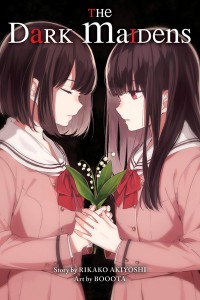Familiar Diversions
I'm a librarian who loves anime, manga, and reading a wide variety of genres.
Currently reading
The Dark Maidens (book) story by Rikako Akiyoshi, art by Booota, translated by Kristi Fernandez

The Dark Maidens is structured like a meeting of the Literature Club at St. Mary's Academy for Girls, a mission school in Japan. It begins with the current club president, Sayuri Sumikawa, opening the meeting by explaining its rules and purpose. This is both one of the club's infamous "mystery stew" meetings and also the first meeting since the club's previous president, Itsumi Shiraishi, either jumped to her death on school grounds or was pushed.
"Mystery stew" meetings are one of the club's traditions. Each member brings an ingredient to add to the stew. At some meetings only edible things are allowed, but at others, such as this one, inedible things may be added, as long as they aren't unsanitary, like bugs or shoes. Each member must eat the stew in darkness until the pot has been completely emptied. While everyone is eating the stew, members take turns telling stories. The theme, this time around, is Itsumi and her death.
I bought this knowing only that it was a mystery and that its author is a woman - my brief check for English-language reviews prior to hitting the "buy" button didn't turn up much. Happily, it turned out to be a quick and interesting read, despite its flaws.
I disliked the format, at first. Sayuri's introductory section was odd and a little awkward, as she described a room the club members she was speaking to should already know and discussed the death of her best and closest friend in what seemed to be a remarkably calm way. Readers were given no sense of what was going on in the room or how Sayuri or the other members were behaving unless Sayuri put those things into words. Fortunately, the stories the club members told were more traditionally written, and I eventually adjusted to Sayuri's parts.
The first character to tell her story was Mirei, one of the school's few scholarship students. After that came Akane, the club member who preferred baking Western-style sweets over reading, then Diana, an international student from a small village in Bulgaria, then Sonoko, a student aiming for medical school who was also Itsumi's academic rival, and then Shiyo, one of the club's first members and the author of an award-winning light novel. The book wrapped up with a story and closing remarks by Sayuri.
The first story, Mirei's, made it crystal clear that this was not going to be a book about female friendship and support. No, these girls were going to verbally tear each other to shreds - apparently in a very neat and orderly manner, since there was never any mention of outbursts and denials in the breaks between stories (I assume there were and it just wasn't included in Sayuri's text, because I cannot imagine a bunch of girls keeping silent as they're each accused of murder).
The second story added an interesting, if not terribly surprising element, as it directly contradicted the first story. From that point on, I started keeping track of details that came up in more than one story, trying to sort the truth from lies. Literally everyone in the room was lying, but what they were lying about and why wasn't always easy to figure out. Also, some stories had more truth to them than I originally assumed.
I can't say whether the translation was very accurate, but it was pretty smooth and readable. I flew through this book like it was nothing, and I appreciated the way the differing styles of some of the stories reflected the characters. For example, Shiyo's story had a very bubbly and conversational style, while Sonoko's was more detached and stiff (at least at the beginning).
As much as I enjoyed attempting to sort out the truth and lies in the girls' stories, this book definitely had a few glaring flaws. The biggest one was the mystery stew. It wasn't believable in the slightest that the club members would willingly eat the stew when they all thought that one of them was a murderer. Heck, one of them even suspected that
I also had trouble believing that the girls would have been as open about some things as they were. For example, one girl shared that she'd been in love with Itsumi, while another girl admitted that she'd lied to Shiyo about having read her book. Several girls said things they had to have known that others in the group would recognize as lies. Why didn't they worry about being called out for it?
Another problem was that Akiyoshi seemed to have trouble keeping certain details straight, or perhaps hadn't thought them through very well. For example, Sayuri said that the usual rule for "mystery stew" meetings was that club members could only bring edible ingredients and that the rule had been changed for this particular meeting, and yet only a few paragraphs later it was clear that inedible items had been allowed in the past. Also, club members were supposed to eat the soup "in total darkness," and yet the room had 1-2 lit candles in it (one by Sayuri, to allow her to put ingredients in the pot, and one by the spot where members were supposed to read their stories). There was enough light for Sayuri to notice that one girl's face had paled, even after she'd left the storytelling spot - hardly "total darkness."
Despite the book's problems, I had a lot of fun with it and could see myself rereading it in the future. Next time, I think I'll start with the final two chapters and then go back to the beginning, just to see if everything really does fit together.
Extras:
Several black-and-white illustrations. One of them shows all the girls at once. When I tried to attach names to faces, I realized that there wasn't enough descriptive information in the text to do that. I know what Sayuri and Itsumi looked like, because they were both introduced with illustrations, but, as far as I can tell, most of the others were never described.
Rating Note:
I feel like I'm probably giving this too high of a rating, because, oof, some of those flaws. But I really did have a lot of fun, especially during the last couple chapters, and I decided to reflect that in my rating.
(Original review posted on A Library Girl's Familiar Diversions.)
 7
7












